
 |
Auklet love potion (and motion)September 04, 2007Courtesy of Far North Science 
A female and male crested auklet, left, engage in alloanointing on St. Lawrence Island in June of 2007. During courtship, females and males intertwine necks, an embrace that helps to distribute the citrus scent in their feathers. Don't click off yet - you're not about to read those sticky porn posts that can gag your trusty Internet filter. But you will find what passes for auklet bliss on the rocky shores of the Bering Sea. A University of Alaska Fairbanks / Kuskokwim Campus biology professor Hector Douglas has uncovered the floral secrets to crested auklet courtship, and their steamy mating ritual sounds like a cross between delousing and edible massage. As UAF writer Marmiam Grimes puts it, "Hitting it off with members of the opposite sex takes chemistry." During their courtship gyrations, the male and female birds rub each other with a "citrus-like scent" secreted from special back feathers that act sort of like wicks. Whether the scent triggers a surge of avian passion or not, Grimes has found the substance might just protect the birds from parasites. Like ticks. Douglas had earlier investigated auklet scents and found that they could actually repel mosquitoes. The most recent paper - Prenuptial perfume: Alloanointing in the social rituals of the crested auklet (Aethia cristatella) and the transfer of arthropod deterrents - was published in the German journal Naturwissenschaften, a monthly publication of advances in natural sciences, medicine and technology. Crested auklets are small black and gray seabirds that nest in huge colonies on remote island cliffs in Alaska and Siberia. They have bright orange bills, white facial plumes and a showy feather crest protruding from their foreheads - possibly an inspiration for various Dr. Suess characters.
Crested auklets in love "During courtship the male solicits the female by adopting a horizontal posture and giving a soft choking call," explained Douglas, an assistant professor of biology at UAF's Kuskokwim Campus. "She rubs her bill and upper body over his wick feathers. Then she offers her wick feathers to the male, and they reciprocate several times, smearing the chemicals over their heads, necks and upper bodies." Douglas observed the unique mating ritual while conducting experiments with lifelike models of crested auklets on St. Lawrence Island, a remote outpost in the northern Bering Sea just 38 miles from Siberia. Douglas concealed chemical dispensers in blocks of construction foam that he painted to resemble rocks. Then he placed the decoys and models on the blocks. "The crested auklets searched for the scent with their heads down in a conspicuous sniffing behavior," Douglas said. "They honed in on the scent, rotating their heads to place their nostrils directly over the dispenser. Then they rubbed their bills over the dispensers just as they would on the wick feathers of their partner. Next, the birds rubbed themselves on the lifelike models right in the area where the wick feathers are located." Douglas used a similar experiment with captive crested auklets at the Cincinnati Zoo to learn if the behavioral response is tuned to breeding. "In two successive years the strongest response to the scent occurred during early courtship," he said. "These combined studies support the idea that the birds communicate with the scent during courtship." But the ritual also seems to have a more pragmatic purpose. "What you smell is what you get in terms of protection against ticks," Douglas said. "The scent contains aldehydes, which repel ticks." Some auklets emit more of the scent than others, he said. Douglas thinks that the birds gain an advantage by anointing with mates that have more of the tick-repelling scent. Douglas measured aldehyde concentrations in feathers and then measured the movement of ticks exposed to the various concentrations. "The ticks exposed to average amounts of citrus scent moved much slower than the controls. They were sluggish, they staggered, and some appeared to be paralyzed," Douglas said. "When the dose was cut in half, the ticks were not as strongly affected. This suggests that the average auklet has adequate defenses, but choose a partner that is below average and that bird will not be as well protected." Birds cannot self-preen their heads and necks, which leaves them vulnerable to ticks in those areas, he said. "When crested auklets anoint their mates, they spread these chemical defenses over these hard-to-reach places, helping protect them against ticks." Many animals use scents in social interactions and Douglas said his study extends scientific knowledge regarding these behaviors. "Alloanointing in vertebrate animals has been understood primarily as a type of social interaction that conveys messages pertaining to individual recognition and the like," said Douglas. "In this case we see that the social cue transmitted in scent can also be adaptive for defending against parasites." |
|